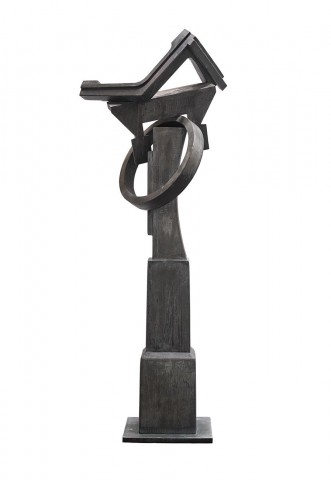THE SENTINEL (No.718b), 1988
ROBERT KLIPPEL
bronze
196.0 cm height
stamped at base: R K 718 88 5/6
Watters Gallery, Sydney
Private collection, Sydney
Edwards, D., Robert Klippel: Catalogue Raisonné of Sculpture, (CD-ROM), Deborah Edwards and the Trustees of the Art Gallery of New South Wales, Sydney, 2002 (illus. CD-ROM Artworks no. 718b)
No. 718, 1988, (a) wood assemblage, Andrew Klippel Collection in Edwards, D., Robert Klippel: Catalogue Raisonné of Sculpture, (CD-ROM), Deborah Edwards and the Trustees of the Art Gallery of New South Wales, Sydney, 2002 (illus.)
The Sentinel, 1988, bronze, edition 1/6, formerly in the Orica Collection, Melbourne
With his singular vision, extraordinary inventiveness of form and unwavering dedication to his private quest for a spiritually relevant aesthetic, Robert Klippel stands alone in the annals of twentieth-century art as one of Australia's most intuitive and original sculptors. From the exquisite surrealist works of the 1940s to the energised junk sculptures of the 1960s, the delicate miniatures and lyrical works on paper to the monumental assemblages, his vast and extremely diverse oeuvre has consistently been inspired by the intricacies of both natural and built environments. Thus juxtaposing organic and mechanical, chance and intent, internal and external, science and religion, his art embodies not so much reconciliation or balance, but rather, as Deborah Edwards observes, ‘...the more subtle desire to forge a new, sometimes irrational, precarious, unforeseen and ultimately delicate equilibrium between his sense of a permanent order and the flux of the modern condition’.1
Elegant in its lucidity of conception and execution, Sentinel (No.718b), 1988 offers a spectacular example from the last great series of Klippel's career which, spanning roughly eight years from the mid eighties to early nineties, is distinguished by a monumentality previously unknown in his art. Although not the gargantuan structures characterising much contemporary art, such assemblages are significantly among some of his most substantial and solid in their weightier enclosed rhythms, sonorous reverberations of energy, and human scale which references not only the sculpture's outer dimensions but also, the clusters, reliefs and recesses of smaller parts held within and upon its surfaces – the ‘tender intimacies’ of Klippel's work.2
An uncompromising declaration of the rigorously non-representational at a time when naturalism, realism and narrative had assumed dominance within contemporary art practice, indeed Sentinel (No.718b) –as its title suggests – poignantly encapsulates the unique and enduring appeal of Klippel’s ever-independent, somewhat solitary creative spirit. As one critic observes, ‘...if his sculpture carries any sort of lesson it is both that important works of art will surely rise out of the present stream, and equally, that one doesn't necessarily have to be in it or with it in order to produce great works of art’.3
1. Edwards, D., Robert Klippel, Art Gallery of New South Wales, Sydney, 2002, p. 17
2. Ibid., p. 189
3. Thomas, L., ‘Cogs and slats in a timeless Klippel - possibly only today’, Australian, 8 February 1969
VERONICA ANGELATOS
